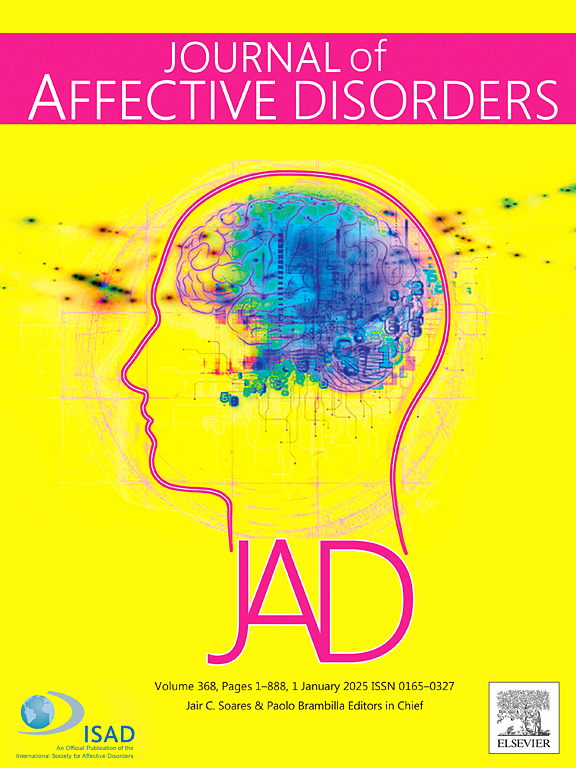Associations between NIH Toolbox Emotion Battery measures and previous suicide attempt in bipolar I disorder
IF 4.9
2区 医学
Q1 CLINICAL NEUROLOGY
引用次数: 0
Abstract
Suicide attempts are more prevalent in people with bipolar I disorder (BD-I) than in the general population. Most prior studies of suicide in BD-I have focused on separate emotion-related assays or clinician-administered scales, whereas a single, brief, and multidimensional battery of self-report measures has not yet been explored. Here, we utilized the NIH Toolbox Emotion Battery (NIHTB-EB) to assess various emotional measures, determine which were cross-sectionally associated with prior suicide attempt in BD-I, evaluate whether the NIHTB-EB could be used to identify past suicide attempt in BD-I with machine learning, and compare model performance versus using clinical mood scales. The study included 39 participants with BD-I and history of suicide attempt, 48 with BD-I without history of suicide attempt, and 58 controls. We found that 9 of the 17 measures were associated with past suicide attempt in BD-I. The initial random forest model indicated that the most important distinguishing variables were perceived stress, emotional support, anger-hostility, anger-physical aggression, perceived rejection, loneliness, and self-efficacy. Overall, the models utilizing NIHTB-EB measures performed better (69.0 % to 70.1 % accuracy) than the model containing clinical mood scale information without the NIHTB-EB measures (57.5 % accuracy). These findings suggest the NIHTB-EB could be a useful and easy-to-deploy tool in understanding the role of emotion-related measures in suicide in BD-I. Furthermore, these results highlight specific emotional subdomains that could be promising targets for longitudinal studies or interventions aimed at reducing suicide in BD-I.
NIH Toolbox Emotion Battery 测量与双相情感障碍 I 期患者之前的自杀企图之间的关系。
自杀企图在双相I型障碍(BD-I)患者中比在一般人群中更为普遍。大多数先前的BD-I自杀研究都集中在单独的情绪相关分析或临床管理的量表上,而单一的、简短的、多维的自我报告测量尚未被探索。在这里,我们利用NIH工具箱情绪电池(NIHTB-EB)来评估各种情绪测量,确定哪些与BD-I中先前的自杀企图相关,评估NIHTB-EB是否可以用于识别过去BD-I中的自杀企图,并将模型性能与临床情绪量表进行比较。该研究包括39名患有BD-I并有自杀企图史的参与者,48名患有BD-I但没有自杀企图史的参与者,以及58名对照组。我们发现17项措施中有9项与BD-I患者过去的自杀企图有关。最初的随机森林模型表明,最重要的区分变量是感知压力、情感支持、愤怒-敌意、愤怒-身体攻击、感知拒绝、孤独和自我效能感。总体而言,使用NIHTB-EB测量的模型比不使用NIHTB-EB测量的包含临床情绪量表信息的模型(57.5 %准确率)表现更好(69.0% %至70.1 %准确率)。这些发现表明,NIHTB-EB可能是一个有用且易于部署的工具,用于理解情绪相关措施在BD-I患者自杀中的作用。此外,这些结果强调了特定的情绪子域,这些子域可能是旨在减少BD-I自杀的纵向研究或干预的有希望的目标。
本文章由计算机程序翻译,如有差异,请以英文原文为准。
求助全文
约1分钟内获得全文
求助全文
来源期刊

Journal of affective disorders
医学-精神病学
CiteScore
10.90
自引率
6.10%
发文量
1319
审稿时长
9.3 weeks
期刊介绍:
The Journal of Affective Disorders publishes papers concerned with affective disorders in the widest sense: depression, mania, mood spectrum, emotions and personality, anxiety and stress. It is interdisciplinary and aims to bring together different approaches for a diverse readership. Top quality papers will be accepted dealing with any aspect of affective disorders, including neuroimaging, cognitive neurosciences, genetics, molecular biology, experimental and clinical neurosciences, pharmacology, neuroimmunoendocrinology, intervention and treatment trials.
 求助内容:
求助内容: 应助结果提醒方式:
应助结果提醒方式:


